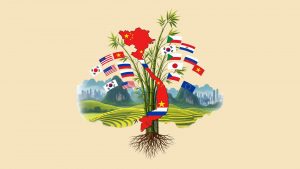From the 2nd February to the 5th February, the Royal Bhutan Army Chief Operations Officer, Lieutenant General Batoo Tshering, visited military institutes and met with the Indian Army chief and National Security Advisor in Delhi.
This may be an indication of stronger defence cooperation or heightened security concerns by Bhutan amid China having built settlements on the territory of Bhutan in recent years. The Indian media expects the situation on the Doklam Plateau to be discussed, which is one of the areas where China extends its presence and infrastructure into disputed areas in the Himalayas confronting Bhutan and India. In this manner, the People’s Republic is developing its hegemony in the Himalayas and expanding its influence into South Asia.
A brief recent History of the Border Disputes between China, India and Bhutan
The border disputes, including violent clashes between members of the Chinese and Indian militaries, date back to the Cold War era and continue to flare up occasionally to this day. Shortly after Narendra Modi became Prime Minister in 2014, he invited Chinese President Xi Jinping to India as part of his multi-vector foreign policy approach, attempting to engage with all major powers. However, Xi’s visit was overshadowed by incursions of the Chinese People’s Liberation Army (PLA) into territories in the disputed Demchok and Chomar regions. Meetings between Xi and Modi a year later improved the confidence in bilateral ties.
Despite the improvement in bilateral ties, a standoff between the two countries’ militaries occurred two years later, in 2017, on the Doklam Plateau, which lies in the border region of India, China, and Bhutan. While troops were recalled after 73 tense days, with escalation looming, bilateral trust between the Chinese and Indian governments was severely damaged.
Chinese activities in the border region aimed at changing the Line of Actual Control (LAC), which the Indian Government describes as efforts to “unilaterally change the status quo”, have led to multiple eruptions of violence. On 15th June 2020, 20 Indian soldiers and an unverified number of Chinese soldiers died in the Galwan Valley following violent cross-border clashes.
While China is interested in expanding the LAC to its advantage, India seeks to restore it to the pre-May 2020 line, before China made significant advancements. This conflict has triggered an arms and military infrastructure race on the “Roof of the World”.
The Demchok Region
At the end of last year, the Chinese authorities created two new counties in its Hotan Prefecture, which borders India to the Southwest of its Ladakh Region. However, these new counties encompass areas that India considers an integral part of its Union Territory of Ladakh.
“India has never accepted the illegal Chinese occupation of Indian territory in the area. We have seen the announcement pertaining to the establishment of two new counties in Hotan Prefecture of China. Parts of the jurisdiction of these so-called counties fall in India’s Union Territory of Ladakh,” a spokesperson for the Ministry of External Affairs commented.
This move by China is widely seen as an attempt to extend and consolidate its control of disputed territories in the Himalayas. The provocation of integrating the disputed territory into its existing administrational system came amid recent diplomatic talks between Indian and Chinese officials on 18th December, when Chinese Foreign Minister, Wang Yi met with Indian National Security Advisor Ajit Doval in Beijing to discuss military disengagement in the disputed areas.
The strategic importance of the Doklam Plateau:
China’s territorial encroachments in the Doklam Plateau, mentioned earlier, bring the Kingdom of Bhutan into the analysis. Bhutan, located in the heart of the Himalayas, borders its larger, nuclear-armed neighbours, India and China. While Bhutan has no official diplomatic relations with China, it enjoys a “special relationship” with India. However, the kingdom on the Roof of the World also has an interest in maintaining predictable relations with China, particularly in light of China’s territorial expansion into Bhutanese territory.
The Doklam Plateau is situated at the intersection of India’s, China’s and Bhutan’s borders. In particular, the Jampheri Ridge in Bhutan holds strategic importance, as its control would allow China to oversee the Siliguri Corridor, a narrow strip of land that connects India’s northeastern states, known as the “Seven Sisters” (including Assam and Manipur), to the rest of the country. This corridor is one of India’s most geopolitically vulnerable regions.
Starting in 2022, a village that China calls Pangda became fully inhabited following its construction. The village lies approximately 6 miles east of the Doklam Plateau, within Bhutanese territory. Additionally, Pangda is located along the Amo Chu River, which could provide China with easier access to the Jampheri Ridge.
These encroachments may seem minor but carry significant strategic implications for both India and Bhutan, giving China an advantage in the border region shared by the three countries. These proactive developments establish “facts on the ground” by expanding infrastructure into territories claimed by India or Bhutan. They also demonstrate the Chinese government’s willingness to deploy substantial resources and engage in confrontations that could lead to further cross-border clashes, as seen in 2020. Through these actions, China aims to push the Line of Actual Control (LAC) further in its favour, securing more strategic territories and increasing its influence in the South Asian region.
- Vegas Von Vogelsteinhttps://asiascot.com/author/vegasvonvogelstein
- Vegas Von Vogelsteinhttps://asiascot.com/author/vegasvonvogelstein
- Vegas Von Vogelsteinhttps://asiascot.com/author/vegasvonvogelstein
- Vegas Von Vogelsteinhttps://asiascot.com/author/vegasvonvogelstein







